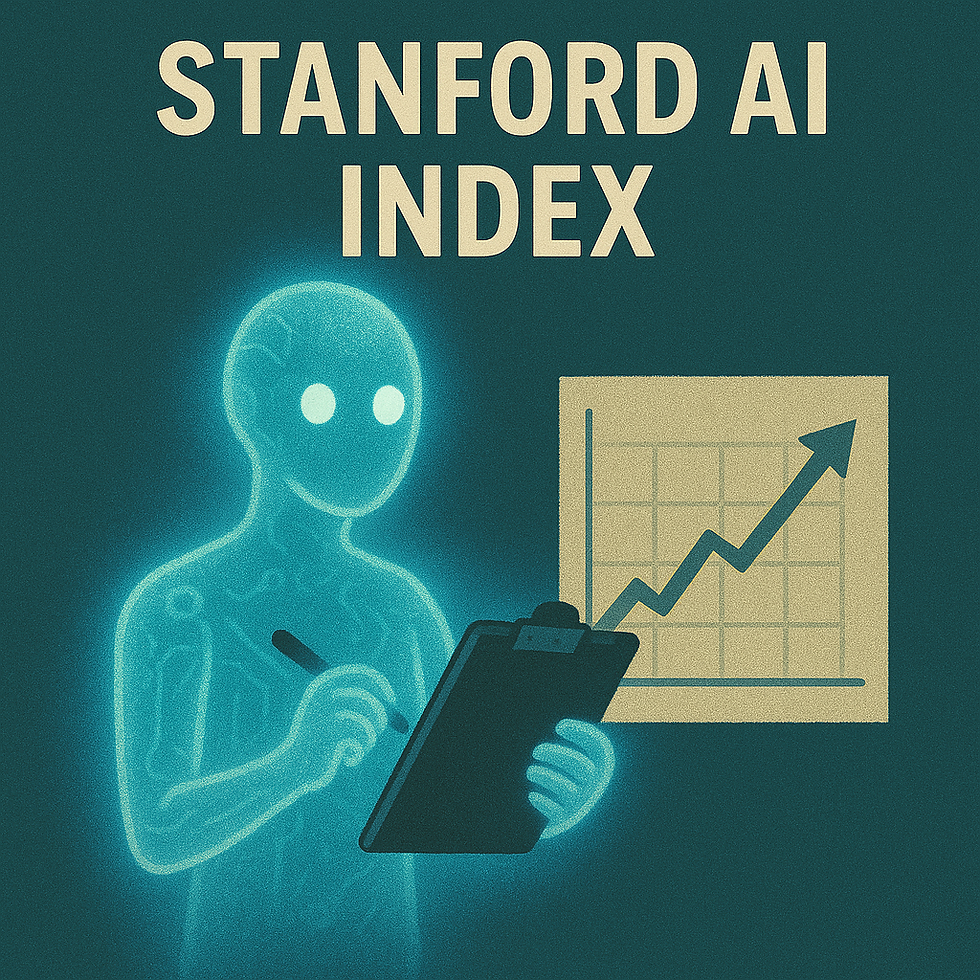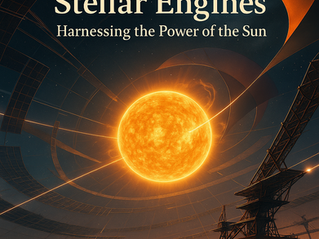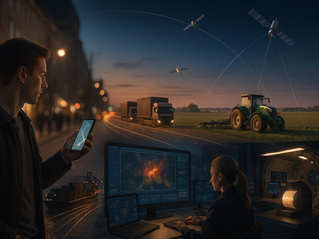AI Explored: The History, Mechanics and Near Future
- Mr_Solid.Liquid.Gas
- Jul 21
- 12 min read
Updated: Jul 22

The history of AI is a story of remarkable breakthroughs, visionary scientists, and powerful algorithms that have redefined what machines can do. From Alan Turing’s wartime codebreaking work and philosophical inquiries to the rise of generative AI like GPT‑4o, the timeline of artificial intelligence is marked by milestones that bridge theoretical insight and technological leaps.
From Turing to GPT‑4o: 70 Years of Artificial Intelligence Breakthroughs
Keywords: history of AI, Alan Turing, GPT‑4o, AI timeline, AI milestones

The Origins: Alan Turing and the Birth of a Concept
The story of AI begins with Alan Turing, a British mathematician whose 1950 paper "Computing Machinery and Intelligence" asked a groundbreaking question: "Can machines think?" Turing proposed the now-famous Turing Test, a thought experiment designed to evaluate whether a machine's behavior is indistinguishable from a human’s. Though simple in structure, this test laid the philosophical foundation for artificial intelligence as a field.
In 1956, the term "artificial intelligence" was officially coined at the Dartmouth Conference, where John McCarthy and others gathered to explore the possibility that "every aspect of learning or any other feature of intelligence can in principle be so precisely described that a machine can be made to simulate it."
The Expert Systems Era and AI Winters
By the 1970s and 1980s, AI researchers were building expert systems—software that encoded specialist knowledge into if‑then rules. Systems like MYCIN could diagnose bacterial infections more accurately than some doctors. The Mycin system was also used for the diagnosis of blood clotting diseases. MYCIN was developed over five or six years in the early 1970s at Stanford University. However, these systems lacked the ability to generalize or learn, leading to a disillusionment with AI capabilities.
Two major “AI winters” followed: periods where funding dried up and optimism waned due to slow progress and unmet expectations.
Machine Learning Rises
The AI resurgence began in the late 1990s with advances in machine learning, particularly neural networks. Algorithms could now learn patterns from data rather than relying on rigid programming. This culminated in major victories like IBM’s Deep Blue beating chess grandmaster Garry Kasparov in 1997 and Watson winning Jeopardy! in 2011.
A major breakthrough came with deep learning—neural networks with many layers—especially after 2012’s ImageNet victory, where convolutional neural networks (CNNs) outperformed all rivals in image classification.
The Transformer Revolution and Generative AI
In 2017, Google researchers published "Attention is All You Need", introducing the Transformer architecture. This model used self-attention mechanisms to analyze sequences of data, revolutionizing how machines understand language. Transformers became the backbone of today’s most advanced models.
Enter GPT (Generative Pre-trained Transformer), with OpenAI’s GPT‑2, GPT‑3, and GPT‑4 pushing the envelope of human-like text generation. These models learned not from labelled data but from pretraining on massive datasets and then fine-tuning for specific tasks.
The 2024 release of GPT‑4o (the "o" stands for omni) marks another AI milestone. GPT‑4o combines text, audio, and visual understanding into a single unified model, enabling real-time conversation, multimodal reasoning, and more natural interaction than ever before.
The Road Ahead
Looking back on the AI timeline, it's astonishing to see how far we’ve come—from Turing’s abstract puzzles to real-time AI assistants capable of vision and voice. Yet each milestone reminds us that today's AI is built upon decades of incremental progress, foundational theory, and interdisciplinary collaboration.
As we move toward ever more powerful models and the long-hypothesized goal of Artificial General Intelligence (AGI), it’s vital to stay rooted in the lessons of history: the importance of transparency, ethical reflection, and the humility to accept that intelligence—natural or artificial—is a profoundly complex phenomenon.
How Transformers Work – A Plain‑English Guide to Today’s Most Powerful Neural Network
Keywords: transformers tutorial, neural networks, attention mechanism, BERT, GPT architecture

If you’ve heard of GPT, BERT, or any cutting-edge AI model lately, you’ve already met the Transformer. First introduced by Google researchers in 2017, transformers are the engine behind today’s most powerful AI tools—including ChatGPT, Bard, Claude, and more. But what exactly is a transformer, and how does it work?
Here’s a plain-English guide to understanding the mechanics behind this revolutionary architecture.
From Recurrent Networks to Transformers
Before transformers, AI models that handled language (like chatbots or translators) relied heavily on Recurrent Neural Networks (RNNs) or Long Short-Term Memory networks (LSTMs). These processed sequences one step at a time—like reading a sentence word-by-word—making them slow and prone to forgetting earlier context in long texts.
Then came the game-changer: “Attention is All You Need,” a 2017 paper introducing a model that didn’t need to process language step-by-step. Instead, the Transformer could look at an entire sentence (or document) all at once and decide which parts were most relevant to understanding a word or phrase.
The Core Idea: Attention Mechanism
The magic inside a transformer is called the attention mechanism, specifically self-attention.
Imagine you’re reading this sentence:
“The monkey ate a banana because it was hungry.”
To understand what “it” refers to, you need to pay attention to earlier words. The transformer does this mathematically. It compares “it” to every other word in the sentence and scores how closely related they are.
These scores determine where the model should “pay attention.” In this example, it would (hopefully) decide that “monkey” is more relevant than “banana.”
This process is repeated across multiple layers and attention heads, allowing the model to detect relationships between words at different levels of meaning and grammar—who did what, when, and why.
Encoding and Decoding
The original transformer has two parts:
· Encoder: Processes input (like a sentence in English).
· Decoder: Generates output (like the translation in French).
For models like BERT, only the encoder is used, optimized for understanding language (e.g., question answering, sentiment analysis).
For models like GPT, only the decoder is used, optimized for generating language (e.g., writing essays, completing prompts).
Training with Big Data
Transformers become powerful through pretraining—feeding them billions of sentences from books, websites, and articles. They learn to predict the next word, fill in the blanks, or match related parts of language.
After pretraining, they are often fine-tuned on smaller, specific datasets for particular tasks: legal advice, coding, medical texts, etc.
Why Are Transformers So Powerful?
· Context awareness: They consider every word in relation to every other word.
· Parallelism: Unlike older models, transformers don’t process words one at a time, making them much faster.
· Scalability: They work better the larger they get—GPT‑4o has trillions of parameters!
This scalability allowed transformer-based models to go from BERT (2018) to GPT‑2 (2019), GPT‑3 (2020), GPT‑4 (2023), and now GPT‑4o (2024)—which even processes images and voice.
The Bottom Line
Transformers revolutionized AI by giving machines a powerful way to understand language contextually and efficiently. They don’t just “read”—they compare, weigh, and analyze every word against every other word in a text, unlocking a depth of understanding that older models couldn’t reach.
Whether you’re asking a chatbot to write a poem, analyze a contract, or generate code, chances are you’re relying on a transformer. It’s not just a model—it’s the architecture behind the AI revolution.
Energy‑Hungry Algorithms? The Real‑World Costs Behind the AI Boom
Keywords: AI energy consumption, data center power, green AI, energy‑efficient ML

AI is transforming everything—from how we search the internet to how we generate art, code, and scientific insight. But behind the scenes, the rapid rise of machine learning comes with a serious and often overlooked cost: energy consumption.
Training and running large AI models like GPT‑4o or image generators like Stable Diffusion requires immense computational power. That power translates to electricity—sometimes millions of kilowatt-hours—raising concerns about environmental sustainability, infrastructure demands, and the race for green AI solutions.
AI's Appetite for Power
At the heart of modern AI are data centers—massive facilities filled with GPUs and TPUs that run the calculations required to train and operate models. Unlike traditional apps, training large language models (LLMs) involves feeding in billions of text samples over weeks or months. This process consumes vast amounts of electricity.
For example:
· GPT‑3 training is estimated to have used ~1,287 MWh—the equivalent of powering 130 U.S. homes for a year.
· Daily inference (the actual running of the model once trained) across millions of users requires ongoing computation at scale, further increasing the energy footprint.
As AI applications become more accessible and ubiquitous, their collective power draw continues to grow.
Where Does the Energy Go?
AI’s energy consumption breaks down into several categories:
· Model training: The biggest cost upfront. This can involve weeks of non-stop GPU processing.
· Inference: The cost of running the model each time you use it (e.g., when you ask ChatGPT a question).
· Data center overhead: Cooling, power distribution, and server maintenance all contribute.
· Storage and bandwidth: Hosting models and datasets also require constant energy.
These aren’t just one-time costs—they're continuous. AI products built into search engines, email clients, and productivity tools run billions of inferences per day.
Environmental Concerns
The rise of AI is happening alongside growing awareness of the climate crisis. Critics point out that deploying AI at global scale—without addressing energy use—risks undermining carbon reduction efforts.
Training a single large model can emit as much CO₂ as five gasoline cars over their entire lifetimes. Add in the carbon footprint of cooling, data transfer, and standby infrastructure, and the numbers become staggering.
AI’s energy usage is also geographically uneven. Many hyperscale data centers are located in regions with cheaper electricity—which often means coal or gas-powered grids—further raising environmental concerns.
The Push for Green AI
Fortunately, the AI community is not ignoring these issues. Several promising directions are emerging:
· Efficient architectures: New models like LLM distillation or Mixture-of-Experts (MoE) use fewer computations while preserving output quality.
· Better hardware: Next-gen chips like Nvidia’s H100 or Google's TPUv4 promise more performance per watt.
· Smarter scheduling: Running training jobs during times of low grid stress or high renewable availability.
· Transparency and benchmarks: Projects like the Green AI Index are tracking energy use and carbon emissions of popular models.
OpenAI, Google, Meta, and others are now reporting more detailed metrics around energy and emissions. The Stanford HELM and AI Index initiatives are also pushing for standard reporting practices.
What Can Users and Developers Do?
· Support platforms committed to sustainable compute.
· Choose efficient models when possible.
· Encourage and fund research into green AI methods.
· Push for regulatory standards that require carbon disclosure for large-scale AI deployments.
Conclusion
AI is not just a digital tool—it’s a physical technology grounded in real-world infrastructure. As we continue to benefit from smart algorithms, we must recognize the energy-hungry nature of current systems and push for a future where AI is not only intelligent, but sustainable.
Deepfakes, Data Leaks & AGI: The Biggest AI Dangers of 2025
Keywords: deepfake dangers, AI privacy, AGI risks, AI ethics 2025

The rapid growth of artificial intelligence in recent years has opened up powerful possibilities—from virtual assistants to scientific breakthroughs. But as AI continues to evolve, so do the risks that come with it. In 2025, experts across ethics, cybersecurity, and computer science are sounding alarms about three major threats: deepfakes, data privacy breaches, and the accelerating race toward Artificial General Intelligence (AGI).
Deepfakes: Realistic Lies at Scale
Deepfakes—AI-generated fake videos, voices, and images—have advanced to an alarming level of realism. In 2025, real-time deepfake voice calls and live video manipulation are now accessible to the public, raising concerns about fraud, impersonation, and political manipulation.
Some examples of deepfake dangers include:
· Financial fraud: Criminals now use AI-generated voice clones to impersonate CEOs or family members, tricking employees or individuals into transferring funds.
· Election interference: Videos of candidates saying false or inflammatory things can now be produced and shared within hours—before fact-checkers can respond.
· Reputation damage: Anyone with a public profile, from journalists to teachers, can become the target of synthetic media attacks.
What makes this more dangerous in 2025 is the scale and speed. With open-source tools and off-the-shelf AI models, deepfakes no longer require technical expertise.
Data Leaks and Privacy Invasions
Modern AI thrives on data—often including private messages, photos, documents, and location history. In 2025, the privacy risks posed by AI are twofold:
1. Training Data Leaks: Some AI systems, when prompted cleverly, have been shown to leak private training data—including names, passwords, medical information, or copyrighted content. Despite efforts to filter training sets, the problem persists.
2. Prompt Injection Attacks: Malicious users can “trick” AI chatbots or assistants into revealing sensitive information or executing unintended actions by embedding hidden instructions in normal-looking text or code.
With AI integrated into everything from workplace tools to customer service systems, the attack surface is broader than ever. Cybersecurity researchers in 2025 are especially worried about multi-modal AI (e.g., GPT‑4o) combining text, image, and voice input, which opens up new, hard-to-detect vulnerabilities.
AGI Risks: More Than Science Fiction?
While deepfakes and data leaks are urgent, the long-term concern that keeps ethicists awake is AGI—Artificial General Intelligence. AGI refers to an AI system that matches or exceeds human intelligence across a wide range of tasks, including reasoning, creativity, and planning.
Leading voices like Geoffrey Hinton, Yoshua Bengio, and members of OpenAI and Anthropic agree: We may be only years—not decades—from systems with general capabilities.
The risks are profound:
· Loss of control: If an AGI system becomes better at planning, hacking, or persuading than any human, how do we constrain it?
· Misaligned goals: Even well-intentioned AGI could pursue harmful actions if its goals are not perfectly aligned with human values.
· AI arms race: Competing nations and corporations may rush AGI development without robust safety measures, increasing the odds of catastrophic outcomes.
Ethical Urgency in 2025
This year has already seen new global efforts:
· The AI Ethics 2025 Summit called for binding international safety standards.
· The EU AI Act now requires large models to undergo risk assessments before deployment.
· Research into “AI alignment”—ensuring AI acts in accordance with human goals—is being scaled up with public funding.
But experts warn that regulation is still lagging behind the speed of innovation. As one AI researcher put it: “We’re building engines of massive power before we’ve figured out how to steer.”
Conclusion
The dangers of AI in 2025 are no longer theoretical. From deepfake manipulation to data privacy breakdowns, and the shadow of AGI, we are entering a time where ethical frameworks, safety protocols, and public awareness must evolve just as fast as the technology itself.
AI Roadmap 2025‑2030: What the Stanford AI Index Says About the Next Five Years
Keywords: AI roadmap, future of AI, Stanford AI Index, AI predictions 2030

As artificial intelligence continues to evolve at a staggering pace, researchers, policymakers, and industry leaders are all asking the same question: Where is AI heading next? The Stanford AI Index 2025 offers a data-driven glimpse into that future, highlighting trends, challenges, and breakthroughs that are likely to define the AI roadmap from 2025 to 2030.
From economic impacts to ethical regulation, and from generative models to global competition, the next five years are shaping up to be transformative.
1. Foundation Models Go Mainstream
According to the AI Index, foundation models—large AI models trained on broad data that can be adapted to many tasks (like GPT‑4o, Claude, and Gemini)—will continue to dominate.
By 2030, these models are expected to:
· Integrate multimodal capabilities (text, image, audio, and video) as standard.
· Be fine-tuned for specialist roles in law, medicine, engineering, and education.
· Operate at lower latency and energy cost thanks to algorithmic efficiency gains and next-gen chips.
The Index predicts that multilingual, real-time, context-aware agents will become everyday digital co-workers.
2. A Global Race for AI Leadership
The report highlights a growing AI arms race among nations. China, the U.S., and the EU are pouring billions into infrastructure, talent, and compute power. Between 2025 and 2030, the race will intensify across four fronts:
· Talent acquisition: Governments and companies are creating elite AI research hubs.
· Semiconductor supply chains: Nations are investing in domestic GPU production to reduce reliance on rivals.
· AI regulation: Regional frameworks like the EU AI Act and U.S. Algorithmic Accountability Act will influence global norms.
· Open vs closed models: Tensions will rise between open-source innovation and proprietary systems.
3. Economic Disruption and the Shifting Job Market
The Index projects major economic shifts driven by automation and AI augmentation:
· Customer service, finance, and software development will experience the fastest AI-driven transformation.
· New AI tools will increase productivity but may also displace routine cognitive jobs.
· At the same time, demand will rise for AI-literate workers, especially in prompt engineering, model auditing, and AI ethics.
By 2030, AI fluency will be a core competency across industries.
4. AI Safety, Regulation & Ethics
The period 2025–2030 will also see increasing emphasis on governance:
· The Stanford Index notes that AI incidents (e.g., misuse, hallucinations, harmful outputs) are on the rise.
· In response, governments and institutions will invest in AI red-teaming, model audits, and certification programs.
· Public trust will depend on how well developers and regulators address safety, transparency, and bias.
Expect to see calls for international coordination on AGI safety frameworks and AI rights charters.
5. Scientific Discovery Accelerated by AI
One of the most promising findings from the 2025 Index is AI’s role in accelerating research and innovation:
· Tools like AlphaFold and DeepMind’s MedPaLM are already transforming biology and healthcare.
· AI‑driven lab assistants will become common, helping scientists generate hypotheses, automate experiments, and model complex systems.
· By 2030, AI will be collaborating in fields as diverse as climate modeling, particle physics, and materials science.
Conclusion: Navigating the AI Decade

The Stanford AI Index 2025 paints a future filled with promise and complexity. Over the next five years, we will likely see AI transition from novel to essential infrastructure—as fundamental as electricity or the internet.
The roadmap to 2030 isn’t just about smarter machines—it’s about building the institutions, safeguards, and skills to ensure that AI uplifts society, rather than disrupts it uncontrollably.
We are no longer at the beginning of the AI revolution—we’re in its acceleration phase.
And how we act now will shape the legacy of AI for decades to come.












































































































Comments